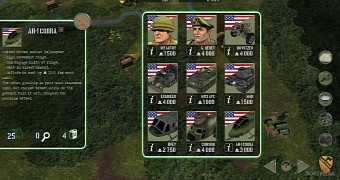When people hear of Vietnam, most of them think about Agent Orange, the American infantry in rice fields, and about the way the conflict ended without a clear military solution.
When I hear of it, I think about books I read when I was younger about Special Operation forces and their missions in the jungle, focused not on killing enemy soldiers but on obtaining information about their movements and capabilities.
Vietnam '65 has Green Berets, who are excellent spotters, and classic Army grunts, who need to take out most of the forces of the Vietcong and the NVA.
But they tend to be vulnerable to surprise attacks and are poorly equipped to move around the rough terrain and to detect their enemies.
The real stars of Vietnam '65 are the helicopters that will make the difference between victory and defeat for the player most of the time.
Carefully managing choppers and keeping them out of the line of fire and working hard at all times is the main strategy gamers need to master in order to keep their entire force working efficiently.
When choppers can no longer deliver their cargo, the entire army suffers and a death spiral quickly engulfs a campaign.
Movement versus supplies
The smartest balancing move for the United States forces that Every Single Soldier has introduced is the fact that every purchase increases the cost of a unit.
The impact is not as big for the basic grunt as it is for a Chinook, and gamers are encouraged to spread their Political Points around and create a mixed force rather than focus on just those units they see as efficient.
This makes it both easier and harder to succeed in Vietnam '65 because players need to find ways to use limited assets in solid ways.
Another big decision is whether to dedicate more time to shuttling units around, benefiting from the extensive move speed of the helicopters, or to restrict them mostly to supply runs.
Vietnam '65 is filled with these kinds of small decisions that manage to show how hard it was to run such a complex war with any semblance of order.
During my first campaign, my casualty numbers among choppers were about 20 percent and I was only able to win the game once I got that down to about 5%.

 14 DAY TRIAL //
14 DAY TRIAL //